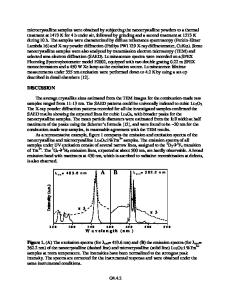Structural and Luminescence Properties of Nanocrystalline Eu 3+ -doped Gd 2 O 3
- PDF / 2,253,322 Bytes
- 6 Pages / 612 x 792 pts (letter) Page_size
- 73 Downloads / 319 Views
1074-I10-41
Structural and Luminescence Properties of Nanocrystalline Eu3+-doped Gd2O3 Segundo Jauregui1,2, Oscar Perales-Perez3, Omar Vasquez1, W. Jia1, M. S. Tomar1, and Esteban Fachini4 1 Physics Department, University of Puerto Rico at Mayaguez, Mayaguez, 00681, Puerto Rico 2 Physics Department, University of Trujillo, Trujillo, Peru 3 Engineering Science & Materials, University of Puerto Rico at Mayaguez, Mayaguez, 006809044, Puerto Rico 4 Chemistry Department, University of Puerto Rico at Rio Piedras, San Juan, Puerto Rico ABSTRACT The present work addresses the synthesis and characterization of red emitting Gd2-xEuxO3 nanocrystalline phosphors by a modified sol-gel based method. The effects of the annealing temperature and atomic fraction of Eu3+ ions, ‘x’, on the structural and luminescence properties of the produced oxides have been systematically investigated. X-ray diffraction analyses revealed that crystalline cubic-Gd2O3 host structure was obtained when the intermediates (x=0.01-0.30) were annealed at different temperatures in air. Photoluminescence spectra of doped Gd2O3 powders showed all transitions of Eu3+ species, being the 5D0 7F2 transition the most intense. On a common sample-weight basis, the highest photoluminescence intensity was obtained at ‘x’= 0.15. The energy transfer from host to dopant was verified for all evaluated ‘x’ values, which suggest the actual incorporation of Eu species into the Gd-oxide lattice. It was also found that the photoluminescence intensity was strongly dependent on the annealing temperature and dopant concentration.
→
INTRODUCTION Nanocrystalline rare-earth (RE) doped phosphors have become the focus of intensive research based on their potential applications in solid sate lasers, lighting and immunoassays systems [1,2]. The quality of luminescence in phosphors is strongly dependent on both, the type of host material and the dopant species. RE sesquioxides (RE2O3), which exhibit three different structures at room temperature [3], are excellent host lattices for trivalent ions. Regarding RE sesquioxides, Gd2O3 is an inorganic insulator with a band gap of 5.4eV [4] and exhibits cubic structure at room temperature. The well-known application of Gd3+ species as contrast agent for magnetic resonance imaging (MRI) opens interesting possibilities of using RE-doped Gd2O3 nanophosphors as multifunctional fluorescence and MRI labels [5]. Among trivalent RE ions, Europium is a well known red emitting species whose sharp photoluminescence (PL) peaks are associated to intra-4f shell transitions. Then, the properties expected in Eu3+-doped Gd2O3 nanostructures justify any effort to optimize the synthesis conditions of this material. Among the several methods to synthesize nanocrystalline phosphors of rare earth oxides, the sol-gel based approach permits a precise compositional control and suitable homogeneity under moderate crystallization temperatures. Most of traditional sol-gel based methods require the use of chelating agents to improve gel viscosity. However, the use of th
Data Loading...











